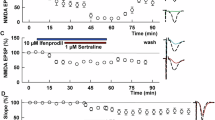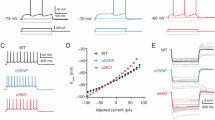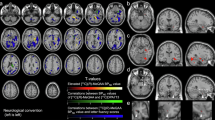Abstract
In this paper, we report on the pharmacological and functional profile of SSR180711 (1,4-Diazabicyclo[3.2.2]nonane-4-carboxylic acid, 4-bromophenyl ester), a new selective α7 acetylcholine nicotinic receptor (n-AChRs) partial agonist. SSR180711 displays high affinity for rat and human α7 n-AChRs (Ki of 22±4 and 14±1 nM, respectively). Ex vivo 3[H]α-bungarotoxin binding experiments demonstrate that SSR180711 rapidly penetrates into the brain (ID50=8 mg/kg p.o.). In functional studies performed with human α7 n-AChRs expressed in Xenopus oocytes or GH4C1 cells, the compound shows partial agonist effects (intrinsic activity=51 and 36%, EC50=4.4 and 0.9 μM, respectively). In rat cultured hippocampal neurons, SSR180711 induced large GABA-mediated inhibitory postsynaptic currents and small α-bungarotoxin sensitive currents through the activation of presynaptic and somato-dendritic α7 n-AChRs, respectively. In mouse hippocampal slices, the compound increased the amplitude of both glutamatergic (EPSCs) and GABAergic (IPSCs) postsynaptic currents evoked in CA1 pyramidal cells. In rat and mouse hippocampal slices, a concentration of 0.3 μM of SSR180711 increased long-term potentiation (LTP) in the CA1 field. Null mutation of the α7 n-AChR gene totally abolished SSR180711-induced modulation of EPSCs, IPSCs and LTP in mice. Intravenous administration of SSR180711 strongly increased the firing rate of single ventral pallidum neurons, extracellularly recorded in anesthetized rats. In microdialysis experiments, administration of the compound (3–10 mg/kg i.p.) dose-dependently increased extracellular acetylcholine (ACh) levels in the hippocampus and prefrontal cortex of freely moving rats. Together, these results demonstrate that SSR180711 is a selective and partial agonist at human, rat and mouse α7 n-AChRs, increasing glutamatergic neurotransmission, ACh release and LTP in the hippocampus.
Similar content being viewed by others

Log in or create a free account to read this content
Gain free access to this article, as well as selected content from this journal and more on nature.com
or
References
Alkondon M, Braga MF, Pereira EF, Maelicke A, Albuquerque EX (2000). alpha7 nicotinic acetylcholine receptors and modulation of gabaergic synaptic transmission in the hippocampus. Eur J Pharmacol 393: 59–67.
Alkondon M, Pereira EF, Eisenberg HM, Albuquerque EX (1999). Choline and selective antagonists identify two subtypes of nicotinic acetylcholine receptors that modulate GABA release from CA1 interneurons in rat hippocampal slices. J Neurosci 19: 2693–2705.
Azam L, Winzer-Serhan U, Leslie FM (2003). Co-expression of alpha7 and beta2 nicotinic acetylcholine receptor subunit mRNAs within rat brain cholinergic neurons. Neuroscience 119: 965–977.
Buhler AV, Dunwiddie TV (2002). alpha7 nicotinic acetylcholine receptors on GABAergic interneurons evoke dendritic and somatic inhibition of hippocampal neurons. J Neurophysiol 87: 548–557.
Canton T, Bohme GA, Boireau A, Bordier F, Mignani S, Jimonet P et al (2001). RPR 119990, a novel alpha-amino-3-hydroxy-5-methyl-4-isoxazolepropionic acid antagonist: synthesis, pharmacological properties, and activity in an animal model of amyotrophic lateral sclerosis. J Pharmacol Exp Ther 299: 314–322.
Cheng Y, Prusoff WH (1973). Relationship between the inhibition constant (K1) and the concentration of inhibitor which causes 50 per cent inhibition (I50) of an enzymatic reaction. Biochem Pharmacol 22: 3099–3108.
Coggan JS, Bartol TM, Esquenazi E, Stiles JR, Lamont S, Martone ME et al (2005). Evidence for ectopic neurotransmission at a neuronal synapse. Science 309: 446–451.
Court J, Spurden D, Lloyd S, McKeith I, Ballard C, Cairns N et al (1999). Neuronal nicotinic receptors in dementia with Lewy bodies and schizophrenia: alpha-bungarotoxin and nicotine binding in the thalamus. J Neurochem 73: 1590–1597.
Court JA, Ballard CG, Piggott MA, Johnson M, O'Brien JT, Holmes C et al (2001). Visual hallucinations are associated with lower alpha bungarotoxin binding in dementia with Lewy bodies. Pharmacol Biochem Behav 70: 571–579.
Cuevas J, Roth AL, Berg DK (2000). Two distinct classes of functional 7-containing nicotinic receptor on rat superior cervical ganglion neurons. J Physiol 525 (Part 3): 735–746.
De Luca V, Wang H, Squassina A, Wong GW, Yeomans J, Kennedy JL (2004a). Linkage of M5 muscarinic and alpha7-nicotinic receptor genes on 15q13 to schizophrenia. Neuropsychobiology 50: 124–127.
De Luca V, Wong AH, Muller DJ, Wong GW, Tyndale RF, Kennedy JL (2004b). Evidence of association between smoking and alpha7 nicotinic receptor subunit gene in schizophrenia patients. Neuropsychopharmacology 29: 1522–1526.
Demuro A, Palma E, Eusebi F, Miledi R (2001). Inhibition of nicotinic acetylcholine receptors by bicuculline. Neuropharmacology 41: 854–861.
Dineley KT, Bell KA, Bui D, Sweatt JD (2002). Beta-Amyloid peptide activates alpha 7 nicotinic acetylcholine receptors expressed in Xenopus oocytes. J Biol Chem 277: 25056–25061.
Dougherty JJ, Wu J, Nichols RA (2003). Beta-amyloid regulation of presynaptic nicotinic receptors in rat hippocampus and neocortex. J Neurosci 23: 6740–6747.
Fabian-Fine R, Skehel P, Errington ML, Davies HA, Sher E, Stewart MG et al (2001). Ultrastructural distribution of the alpha7 nicotinic acetylcholine receptor subunit in rat hippocampus. J Neurosci 21: 7993–8003.
Flesher JE, Scheffel U, London ED, Frost JJ (1994). In vivo labeling of nicotinic cholinergic receptors in brain with [3H]cytisine. Life Sci 54: 1883–1890.
Frazier CJ, Buhler AV, Weiner JL, Dunwiddie TV (1998). Synaptic potentials mediated via alpha-bungarotoxin-sensitive nicotinic acetylcholine receptors in rat hippocampal interneurons. J Neurosci 18: 8228–8235.
Freedman R, Adams CE, Leonard S (2000). The alpha7-nicotinic acetylcholine receptor and the pathology of hippocampal interneurons in schizophrenia. J Chem Neuroanat 20: 299–306.
Freedman R, Leonard S, Gault JM, Hopkins J, Cloninger CR, Kaufmann CA et al (2001). Linkage disequilibrium for schizophrenia at the chromosome 15q13-14 locus of the alpha7-nicotinic acetylcholine receptor subunit gene (CHRNA7). Am J Med Genet 105: 20–22.
Fujii S, Ji Z, Sumikawa K (2000). Inactivation of alpha7 ACh receptors and activation of non-alpha7 ACh receptors both contribute to long term potentiation induction in the hippocampal CA1 region. Neurosci Lett 286: 134–138.
Furuta T, Koyano K, Tomioka R, Yanagawa Y, Kaneko T (2004). GABAergic basal forebrain neurons that express receptor for neurokinin B and send axons to the cerebral cortex. J Comp Neurol 473: 43–58.
Golmayo L, Nunez A, Zaborszky L (2003). Electrophysiological evidence for the existence of a posterior cortical-prefrontal-basal forebrain circuitry in modulating sensory responses in visual and somatosensory rat cortical areas. Neuroscience 119: 597–609.
Gopalakrishnan M, Monteggia LM, Anderson DJ, Molinari EJ, Piattoni-Kaplan M, Donnelly-Roberts D et al (1996). Stable expression, pharmacologic properties and regulation of the human neuronal nicotinic acetylcholine alpha 4 beta 2 receptor. J Pharmacol Exp Ther 276: 289–297.
Grassi F, Palma E, Tonini R, Amici M, Ballivet M, Eusebi F (2003). Amyloid beta(1-42) peptide alters the gating of human and mouse alpha-bungarotoxin-sensitive nicotinic receptors. J Physiol 547: 147–157.
Gray R, Rajan AS, Radcliffe KA, Yakehiro M, Dani JA (1996). Hippocampal synaptic transmission enhanced by low concentrations of nicotine. Nature 383: 713–716.
Gritti I, Mainville L, Mancia M, Jones BE (1997). GABAergic and other noncholinergic basal forebrain neurons, together with cholinergic neurons, project to the mesocortex and isocortex in the rat. J Comp Neurol 383: 163–177.
Harker KT, Whishaw IQ (2002). Impaired spatial performance in rats with retrosplenial lesions: importance of the spatial problem and the rat strain in identifying lesion effects in a swimming pool. J Neurosci 22: 1155–1164.
Hunter BE, de Fiebre CM, Papke RL, Kem WR, Meyer EM (1994). A novel nicotinic agonist facilitates induction of long-term potentiation in the rat hippocampus. Neurosci Lett 168: 130–134.
Jones IW, Wonnacott S (2004). Precise localization of alpha7 nicotinic acetylcholine receptors on glutamatergic axon terminals in the rat ventral tegmental area. J Neurosci 24: 11244–11252.
Khiroug SS, Harkness PC, Lamb PW, Sudweeks SN, Khiroug L, Millar NS et al (2002). Rat nicotinic ACh receptor alpha7 and beta2 subunits co-assemble to form functional heteromeric nicotinic receptor channels. J Physiol 540: 425–434.
Kihara T, Sawada H, Nakamizo T, Kanki R, Yamashita H, Maelicke A et al (2004). Galantamine modulates nicotinic receptor and blocks Abeta-enhanced glutamate toxicity. Biochem Biophys Res Commun 325: 976–982.
Lanneau C, Harries MH, Ray AM, Cobb SR, Randall A, Davies CH (2002). Complex interactions between mGluR1 and mGluR5 shape neuronal network activity in the rat hippocampus. Neuropharmacology 43: 131–140.
Lowry OH, Rosebrough NJ, Farr AL, Randall RJ (1951). Protein measurement with the Folin phenol reagent. J Biol Chem 193: 265–275.
Lukas RJ (1986). Characterization of curaremimetic neurotoxin binding sites on membrane fractions derived from the human medulloblastoma clonal line, TE671. J Neurochem 46: 1936–1941.
Lukas RJ (1993). Expression of ganglia-type nicotinic acetylcholine receptors and nicotinic ligand binding sites by cells of the IMR-32 human neuroblastoma clonal line. J Pharmacol Exp Ther 265: 294–302.
Lukas RJ, Morimoto H, Bennett EL (1979). Effects of thio-group modification and Ca2+ on agonist-specific state transitions of a central nicotinic acetylcholine receptor. Biochemistry 18: 2384–2395.
Marchi M, Risso F, Viola C, Cavazzani P, Raiteri M (2002). Direct evidence that release-stimulating alpha7 nicotinic cholinergic receptors are localized on human and rat brain glutamatergic axon terminals. J Neurochem 80: 1071–1078.
Marks MJ, Stitzel JA, Romm E, Wehner JM, Collins AC (1986). Nicotinic binding sites in rat and mouse brain: comparison of acetylcholine, nicotine, and alpha-bungarotoxin. Mol Pharmacol 30: 427–436.
Nelson ME, Wang F, Kuryatov A, Choi CH, Gerzanich V, Lindstrom J (2001). Functional properties of human nicotinic AChRs expressed by IMR-32 neuroblastoma cells resemble those of alpha3beta4 AChRs expressed in permanently transfected HEK cells. J Gen Physiol 118: 563–582.
Nishizaki T, Matsuoka T, Nomura T, Kondoh T, Watabe S, Shiotani T et al (2000). Presynaptic nicotinic acetylcholine receptors as a functional target of nefiracetam in inducing a long-lasting facilitation of hippocampal neurotransmission. Alzheimer Dis Assoc Disord 14 (Suppl 1): S82–S94.
Nordberg A (2001). Nicotinic receptor abnormalities of Alzheimer's disease: therapeutic implications. Biol Psychiatry 49: 200–210.
Orr-Urtreger A, Goldner FM, Saeki M, Lorenzo I, Goldberg L, De Biasi M et al (1997). Mice deficient in the alpha7 neuronal nicotinic acetylcholine receptor lack alpha-bungarotoxin binding sites and hippocampal fast nicotinic currents. J Neurosci 17: 9165–9171.
Pabreza LA, Dhawan S, Kellar KJ (1991). 3H]cytisine binding to nicotinic cholinergic receptors in brain. Mol Pharmacol 39: 9–12.
Parker MJ, Beck A, Luetje CW (1998). Neuronal nicotinic receptor beta2 and beta4 subunits confer large differences in agonist binding affinity. Mol Pharmacol 54: 1132–1139.
Paxinos G, Watson C (1998). The Rat Brain in Stereotaxic Coordinates, 4th edn. Academic Press: New York.
Perry EK, Martin-Ruiz CM, Court JA (2001). Nicotinic receptor subtypes in human brain related to aging and dementia. Alcohol 24: 63–68.
Pichat P, Bergis OE, Terranova JP, Duarte C, Santucci V, Gueudet C et al (2006). SSR180711A, a novel selective 7 nicotinic receptor partial agonist: II) Efficacy in experimental models predictive of activity against cognitive symptoms of schizophrenia. Neuropsychopharmacology, advance online publication, August 23, 2006; doi:10.1038/sj.npp.1301188.
Quik M, Choremis J, Komourian J, Lukas RJ, Puchacz E (1996). Similarity between rat brain nicotinic alpha-bungarotoxin receptors and stably expressed alpha-bungarotoxin binding sites. J Neurochem 67: 145–154.
Radcliffe KA, Fisher JL, Gray R, Dani JA (1999). Nicotinic modulation of glutamate and GABA synaptic transmission of hippocampal neurons. Ann NY Acad Sci 868: 591–610.
Reno LA, Zago W, Markus RP (2004). Release of [(3)H]-L-glutamate by stimulation of nicotinic acetylcholine receptors in rat cerebellar slices. Neuroscience 124: 647–653.
Rezvani AH, Levin ED (2001). Cognitive effects of nicotine. Biol Psychiatry 49: 258–267.
Sawada S, Ohno-Shosaku T, Yamamoto C (1994). Augmenting action of nicotine on population spikes in the dentate gyrus of the guinea pig. Neurosci Res 20: 317–322.
Schoepfer R, Luther M, Lindstrom J (1988). The human medulloblastoma cell line TE671 expresses a muscle-like acetylcholine receptor. Cloning of the alpha-subunit cDNA. FEBS Lett 226: 235–240.
Severance EG, Cuevas J (2004). Distribution and synaptic localization of nicotinic acetylcholine receptors containing a novel alpha7 subunit isoform in embryonic rat cortical neurons. Neurosci Lett 372: 104–109.
Steinberg R, Rodier D, Souiclhac J, Bougault I, Emonds-Alt X, Soubrie P et al (1995). Pharmacological characterization of tachykinin receptors controlling acetylcholine release from rat striatum: an in vivo microdialysis study. J Neurochem 65: 2543–2548.
Stip E, Chouinard S, Boulay LJ (2005). On the trail of a cognitive enhancer for the treatment of schizophrenia. Prog Neuropsychopharmacol Biol Psychiatry 29: 219–232.
Strong R, Reddy V, Morley JE (2003). Cholinergic deficits in the septal-hippocampal pathway of the SAM-P/8 senescence accelerated mouse. Brain Res 966: 150–156.
Tribollet E, Bertrand D, Marguerat A, Raggenbass M (2004). Comparative distribution of nicotinic receptor subtypes during development, adulthood and aging: an autoradiographic study in the rat brain. Neuroscience 124: 405–420.
Wang F, Nelson ME, Kuryatov A, Olale F, Cooper J, Keyser K et al (1998). Chronic nicotine treatment up-regulates human alpha3 beta2 but not alpha3 beta4 acetylcholine receptors stably transfected in human embryonic kidney cells. J Biol Chem 273: 28721–28732.
Acknowledgements
We thank Thibault De Gallier, Catherine Marc and Nicole Brunel for their excellent technical assistance, Jean-Michel Lefevre for having provided transgenic mice, Véronique Onado and Mathieu Rose for their helpful contribution to data analysis.
Author information
Authors and Affiliations
Corresponding author
Rights and permissions
About this article
Cite this article
Biton, B., Bergis, O., Galli, F. et al. SSR180711, a Novel Selective α7 Nicotinic Receptor Partial Agonist: (1) Binding and Functional Profile. Neuropsychopharmacol 32, 1–16 (2007). https://doi.org/10.1038/sj.npp.1301189
Received:
Revised:
Accepted:
Published:
Issue date:
DOI: https://doi.org/10.1038/sj.npp.1301189
Keywords
This article is cited by
-
Involvement of α7nAChR in the Protective Effects of Genistein Against β-Amyloid-Induced Oxidative Stress in Neurons via a PI3K/Akt/Nrf2 Pathway-Related Mechanism
Cellular and Molecular Neurobiology (2021)
-
Dorsal hippocampal brain receptor complexes linked to the protein synthesis-dependent late phase (LTP) in the rat
Brain Structure and Function (2015)
-
The Therapeutic Potential of α7 Nicotinic Acetylcholine Receptor (α7 nAChR) Agonists for the Treatment of the Cognitive Deficits Associated with Schizophrenia
CNS Drugs (2015)
-
Imaging of α7 nicotinic acetylcholine receptors in brain and cerebral vasculature of juvenile pigs with [18F]NS14490
EJNMMI Research (2014)
-
Effect of alpha7 nicotinic acetylcholine receptor agonists on attentional set-shifting impairment in rats
Psychopharmacology (2014)


